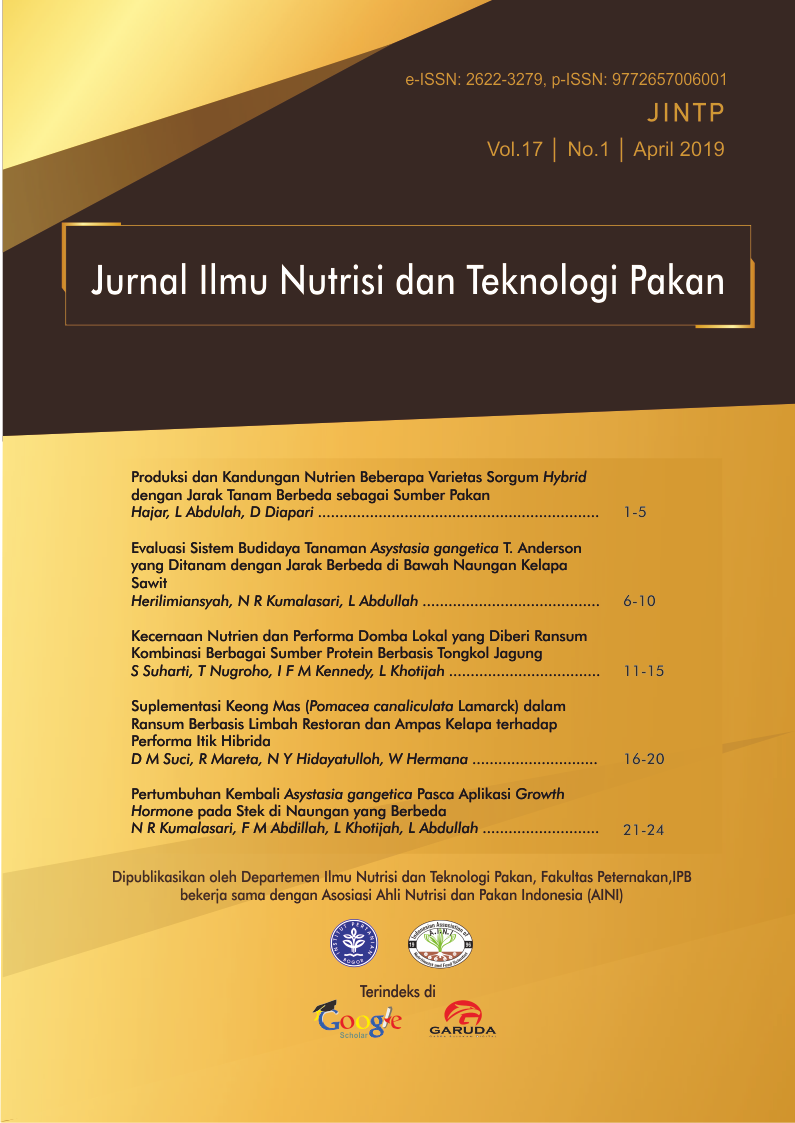Produksi dan Kandungan Nutrien Beberapa Varietas Sorgum Hybrid dengan Jarak Tanam Berbeda sebagai Sumber Pakan
Abstract
Sorghum feed is a type of cereal plant that has potential use as animal feed or forage. The reseach aim was to evaluate production and nutritional quality of some sorghum hybrid varieties, and determined the optimal spacing of sorghum plants. This research was arranged in a factorial randomized block design with 6 treatments and four replications. The first factor was the varieties of 12FS9006, 13FB7001 and 12S49001. The second factor was space of 25x25 cm and 25x40 cm. The variables were fresh and dry matter of biomass production and also nutrient (ash, crude fiber, crude protein, Neutral Detergen Fiber and Acid Detergen Fiber. Sorghum varieties had significant effect (p<0.05) to fresh biomass production, dry matter biomass production, ash, crude fiber and crude protein). The space had a significant effect (p<0.05) to the dry matter production of biomass and crude fiber. The average variety of fresh biomass plant production was (18.90 tons ha-1), dry matter production of biomass was (4 ton ha-1), ash (5.51%), crude fiber (30.90%) and crude protein (8.45%). The average dry matter production was 4.34 tons ha-1 and crude fiber 29.96%. It can be concluded that the highest production and the best nutrient quality of sorghum hybrid was obtained at the sorghum variety of 12S49001, the distance of 25x25 cm was the best plant space for hybrid sorghum production.
Keywords: hybrid varieties, nutrient, plant space, production
Downloads
References
Ardi DW,Gembong H &Yulia ES. 2016. Pengaruh jumlah tanaman perlubang dan jarak tanam terhadap hasil anaman kacang tanah (Arachis Hypogea, L.Var. Kancil. VIGOR: Jurnal Ilmu Pertanian Tropika dan Subtropika 3 (1) : 5 -8
Ayub M, Nadeem MA, Tanveer A & Husnain A. 2002. Effect of different levels of nitrogen and harvesting times on the growth, yield and quality of sorghum fodder.Asian Journal of Plant Science. 1 (4): 304-307.
Butler TJ, & Muir JP. 2003. Row spacing and maturity of forage
sorghum silage in north central Texas. Forage Research in Texas, http://forageresearch.tamu.edu/2003/Forage Sorghum.pdf
Purnomohadi M. 2006 Potensi penggunaan beberapa varietas sorgum manis (Sorghum bicolor (L.)Moench) sebagai tanaman pakan. Berkala Penelian Hayati: 12: (41-44)
Dicko MH, Gruppen H, Traore AS, Van Berkel WJH & Voragen AG.2005. Evaluation of the effect of germination on phenolic compounds and antioxidant activities in sorghum varieties. JournalAgricultural and FoodChemistry. 53(7):2581-2588.
Febriyono R, Eko YS & Suprapto A. 2017. Peningkatan hasil tanaman kangkung darat (Ipomoea reptans, l.) melalui perlakuan jarak tanam dan jumlah tanaman per lubang. Jurnal Ilmu Pertanian Tropika dan Subtropika (Vigor). 2 (1) : 22-27
Haryadi D, Yetti H &Yoseva S. 2015. Pengaruh pemberian beberapa jenis pupuk terhadap pertumbuhan dan produksi tanaman Kailan (Brassica alboglabra L). Jurnal online Mahasiswa Fakultas Pertanian 2 (2) :1-10
Lemerle D, Verbeek B & Diffy S. 2006. Influence of field pea (Pisumsativum) density on grain yield and competitiveness with annual rye grass (Loliumrigidum) in south eastern Australia. Australian Journal of Experimental Agriculture 46 (11): 1465- 1472.
Koten B, Soetrisno R, Ngadiyono N & Suwignyo B. 2012. Production of sorghum plant (Sorghum bicolor (l.) moench) of rote localvariety as forage for ruminant feed at different of harvest time and urea levelBuletinPeternakan. 36(3): 150-155. Doi:10.21059.
KurniawanW.2014. Potential values of numbu, cty-33 and bmr sorghum as feed grown in ultisol sedimentation soil with different levels of organic fertilizer. [tesis].Bogor (ID): Institut Pertanian Bogor.
Linn JG & Martin NP. 1991. Forage quality analysis and interpretation. Veterinary Clinics of North America : Food Animal Practice. 7(2):509-23.
Made DG. 2017. Pertumbuhan dan produksi beberapa varietas tanaman sorgum pakan hijauan hybridpada sistem monokultur(skripsi).Bogor (ID): Institut Pertanian Bogor
McMurray L. 2004. Plant density inputs Kaspa field pea‟s grain yield. Australian Farm Journal.45-46.
McRae FJ, McCaffery DW & Mathews PW. 2008. Winter crop variety sowing guide. NSW, Department of Primary Industries, 74-85.
Miron J, SolomonR,Adin G,Nir U, Nikbachat M, Yosef E,CarmiA,Weinberg ZG, KipnisT, ZuckermanE & BenGhedalia D. 2006. Effects of harvest stage and re-growth on yield, composition, ensilage and invitro digestibility of new forage sorghum varieties. Journal of the Science of Food and Agricultural86(1) : 140–147.
Nabi CG, Riaz M &Ahmad G. 2006. Comparison of some advanced
lines of Sorghum bicolor L. Monech for green fodder/dry matter
yields and morpho-economic parameters. Journal of Agricultural Research 44 (3) : 191–196.
Puteri ER.2015. Productivity and nutrient content of some sorghum mutant lines at different cutting age levels [tesis]. Bogor (ID): Bogor Agricultural University.
Rahma A. 2014. Pengaruh pupuk organik cair berbahan dasar limbah sawi putih (brassica chinensis l) terhadap pertumbuhan tanaman jagung manis (zea mays l. var. saccaharata). Laporan penelitian. Universitas Diponegoro.
Redfearn D & Zhang H. 2016. Forage quality interpretations. Oklahoma Cooprative Extension Service. PPS-2117.
Rianto E. Purbowati E. 2013. Paduan lengkap sapi potong. Penerbar Swadaya. Jakarta.
Rosser CL. Gorka P. Beattie AD. Block HC, Mckinnon JJ. Lardner HA & Penner GB. 2013. Effect of maturity at harvest on yield, chemical composition, and in situ degradability for annual cereals used for swath grazing. Journal of Animal Science. 91(8) :3815-3826.
Sihono 2013. Uji adaptasi galur mutan harapan sorgum manis hasil iradiasi di CTY33 Bogor. Prosiding Seminar Nasional Sains dan Teknologi NuklirPTNBR - BATAN Bandung.
Soeranto H. 2011. Riset dan pengembangan sorgum dan gandum untuk ketahanan pangan. Pusat Aplikasi Teknologi Isotop dan Radiasi. Badan Tenaga Nuklir Nasional (Batan)
Solichatun. Anggarwula E & Mudyantini N. 2005. Pengaruh ketersediaan air terhadap pertumbuhan dan kandungan bahan aktif saponin tanaman ginseng jawa(Talinumpaniculatum, gaertn.) http://biosains.mipa.uns.ac.id/F/F0302/F030203.pdf. Diunduh 6 Juli 2018.
Sriagtula R.2016. Growth Biomass and Nutrient Production of Brown Midrib Sorghum Mutant Lines at Different Harvest Time [dissertation]. Bogor (ID): Bogor Agricultural University.
Subramanian SK. 2013. Agronomical, physiological and biochemical approaches to characterize sweet sorghum genotypes for biofuel production[dissertation]. Kansas State University, Manhattan. Kansas.
Sudarmadji S. Haryono B & Suhardi. 2003. Analisa Bahan Makanan dan Pertanian. Penerbit Liberty Yogyakarta bekerja sama dengan pusat antar universitas pangan dan gizi Universitas Gadjah Mada. Yogyakarta.
Susilowati YE. 2011. Pengaruh jarak tanam dan jumlah biji perlubangtanamterhadap hasil baby corn. Jurnal Inovasi. LPPM Universitas Tidar Magelang. 36 (2) : 52 – 63.
Tillman, A.D., H. Hartadi, S. Reksohadiprojo, S. Prawirokoesoemo & S. Lebdosoekojo. 1991. Ilmu Makanan Ternak Dasar. Edisi ke-5. Gadjah Mada University Press, Yogyakarta.
The authors of the submitted manuscript have to understand and agree that the copyrights published are held by Jurnal Ilmu Nutrisi dan Teknologi Pakan. Copyrights includes rights in reproducing, distributing and selling every section of articles in all forms and media. The copyright transfer form is signed by the corresponding author. The author”
• Creative Commons Attribution (CC BY)
you are allowed to:
Share – copy and redistribute the material in any medium or format
Adapt – remix, transform, and build upon the material
for any purpose, even commercially.
The licensor cannot revoke these freedoms as long as you follow the license terms.
Jurnal Ilmu Nutrisi dan Teknologi Pakan (Nutrition and Feed Technology Journal)

This work is licensed under a Creative Commons Attribution 4.0 International License.












